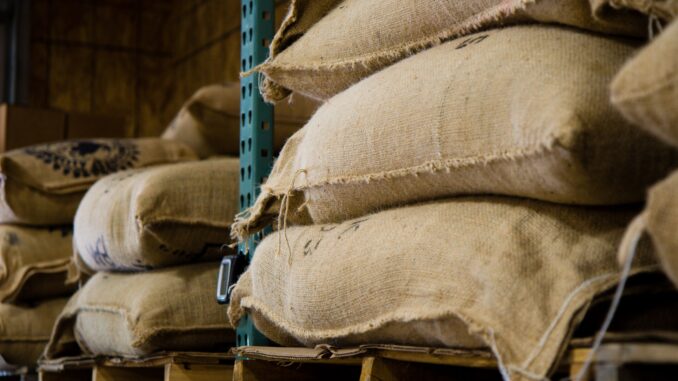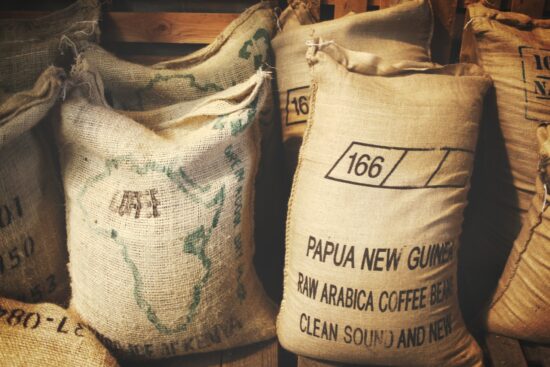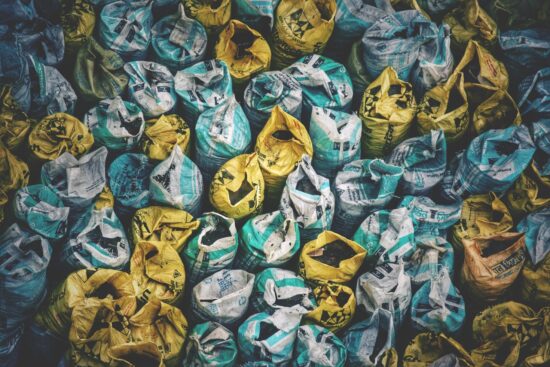
Certain materials play a major role in preventing mold and decay in raw coffee.
BY TANYA NANETTI
SPECIAL TO BARISTA MAGAZINE ONLINE
Cover photo by Caelen Cockrum for Unsplash
As many seasoned coffee professionals know, when it comes to green coffee storage, the long journey of crop to cup begins at the farm. After the seeds get processed into raw green coffee, producers package it in large bags that vary in material. They often store these bags for a long time before shipping their precious cargo to roasters worldwide.
Considering the potential duration of this long journey—especially when the green coffee is shipped overseas and exposed to high levels of humidity—it is imperative that the coffee is packed in the most suitable way. A priority in green coffee storage is better preservation from degradation.
Of course, some level of degradation over a long time cannot be avoided. However, the choice of packaging material can help slow down this decomposition process. Some of the most common materials for coffee packaging are burlap, plastic, high-barrier, and vacuum.

Burlap
Traditionally, burlap has been the material of choice for green coffee storage bags. Burlap is a fabric made from a jute plant, so it’s recyclable and biodegradable. It’s also simply durable and affordable, especially when compared to more high-tech solutions. This usually makes it a first choice for farmers, especially those who are shipping coffees without delay.
However, it’s possible for liquids and gasses to pass through burlap, so it doesn’t protect the beans from oxygen and humidity. This ultimately can result in poor coffee quality, with defects like mold.
Additionally, the traditional size of burlap bags can carry only 60 or 70 kg of coffee. The newest plastic bags, on the other hand, can often store several tons of coffee.
Plastic
Plastic bags, which range in sizes from the traditional 60 kilo bags to huge container liners, are in comparison cheaper and more resistant to oxygen and moistures, but are permeable to a certain degree.
High-Barrier
A popular style of green coffee storage bags is high-barrier, which is highly waterproof and often lined within burlap bags. They are more expensive than other storage materials, but excel at creating a barrier between coffee, oxygen, and moisture, therefore preserving coffee quality more efficiently. They also come in different sizes that reach container liners.
One brand that specializes in this style of packaging is GrainPro, which offers a variety of hermetic bags. Although the up-front costs of these bags are an investment, their long-term storage capabilities make them a fitting decision for farmers who need a place to store coffees without worrying about degradation.
According to Diego Lara at GrainPro, “GrainPro bags have a deep positive impact on the entire agricultural production chain, since they provide an airtight environment with low levels of oxygen and high levels of CO2. … With this, GrainPro generates a commercial improvement for all small farmers, increasing their income, in addition to promoting the use of fresher and quality commodities for companies of all sizes.”
Another brand that has developed an eco-friendly approach to this style of high-barrier packaging is Savor Brands; their Hermética bags are formulated with nylon and EVOH layers of material. These bags are also recyclable through their PONO program, which takes used coffee bags to repurpose and reprocess. According to Marc Marquez at Savor, “Hermética is THE premium solution for green coffee protection. Offering Nylon and EVOH barrier layers to keep the fruits of your labor safe, Hermética maintains the quality of your coffee in its journey from origin to roaster.”

Vacuum
The mostly costly of all methods mentioned is the vacuum system. With vacuum, the coffee is still stored in plastic bags, but without any oxygen. Mimicking the standard vacuum-seal bags for roasted coffee, it is often considered the best method of green coffee storage as well. However, its high price means it is only used to store and ship micro- and nano-lots—or even samples—of high-quality specialty coffees.
In Conclusion
Considering how many different types of methods exist for green coffee storage, we can understand that the preferred storage depends on the type of coffee being shipped.
When shipping delicate specialty coffees, storing them in some kind of impermeable bag will help prevent their rapid decay. At the same time, large quantities of commercial coffee will probably be shipped in simple plastic container liners, permeable but also affordable. However, modest quantities of coffee—both specialty and commercial—will always be stored and shipped in traditional burlap coffee bags.
ABOUT THE AUTHOR
Tanya Nanetti (she/her) is a specialty-coffee barista, a traveler, and a dreamer. When she’s not behind the coffee machine (or visiting some hidden corner of the world), she’s busy writing for Coffee Insurrection, a website about specialty coffee that she’s creating along with her boyfriend.

